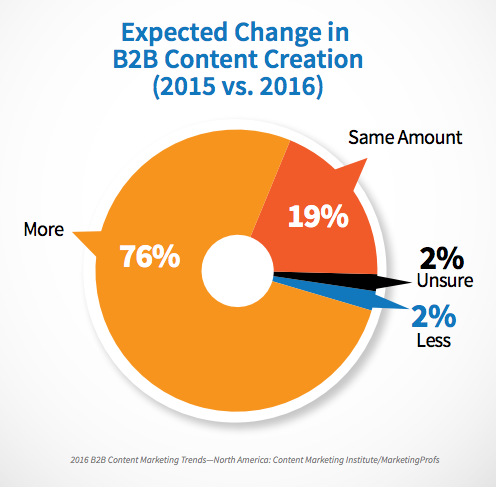I’m scrolling down my Twitter feed and the headlines pass by like unappetizing food in a buffet line.
“Twitter is Dead!”
“7 Ways to Boost Your Blog Traffic”
“47 Experts Share Their Best-Kept Growth Secret”
“The Giant Mistake You’re Making on LinkedIn”
“The 22 SEO Basics You Need for Optimizing Your Site Right Now”
“Bots! AI! VR!”
I get it. These are the types of headline tactics that work. Getting people to click is the first step to content discovery, and appealing to emotions (even negative ones) is the fastest way to earn that click or tap. But so many times – oh, so many times – the content that lies behind those hyperbolic headlines disappoints.
Lists slapped together from other people’s quotes. Content so basic it was clearly not created for anyone who might click the headline. Re-hashes of someone else’s article.
Content marketing is everyone’s darling right now, and its proportion of the marketing pie has been growing for years. It’s clear why – excellent content connects with audiences in a way few advertising campaigns or other marketing tactics can. When done right, it’s a winning strategy.
Founders and marketers face a lot of pressure to produce content, to play the game even if it’s a crowded field, because the alternative could be missing out on something that’s working for other companies right now.
As a result, we’re inundated with subpar content. This is content created simply for the sake of creating an article on a topic, labeled with a melodramatic headline and pushed out into the Internet ether.
Can’t we do better?
Why We All Start to Move Toward Groupthink
When you’re working hard to build a business or grow an audience, it’s natural to want to read as much as you can about all the topics that rule that process: branding, marketing, founder tips, pitching, content marketing, social media, speaking engagements, and more.
The problem arises when we’re all reading the same things and living only in that world all day long.
We inevitably start to absorb all that content not as ideas that should be part of a conversation, but as facts to be regurgitated later in an effort to create similar content ourselves.
Groupthink happens more easily in social settings. In our quest to become creators, we seek to read the work of others to be inspired and bolster our own thoughts, but in the process we’re unwittingly shutting down our own creativity and ability to think independently.
Ways we can do better:
1. Read (and Listen) Widely

Credit: Unsplash
Rather than bouncing around inside a content echo chamber and reading all the same material everyone else is consuming and producing, try leaving your own industry behind for most of your reading material.
Start by curating your own industry sources very carefully.
You will need to read within your own industry, of course, to stay informed and potentially discover a rare gem of content that can change your own work. But instead of reading everything and scrolling through endless streams of the same old content, curate your sources so that you’re reading the best of the best.
Take note of the places where you found those excellent pieces of content and add them to a list. Spend your time reading from your curated list rather than wading around in subpar content.
If you follow the blogs and authors of the pieces you enjoy, you can discover more publications and authors through your original list’s recommendations. This keeps the industry content you consume at a high quality level.
Then read anything else.
Seriously, anything but an industry piece. Read fiction. Read magazines. Read nonfiction in completely different subjects. Listen to podcasts that have nothing to do with your job. Talk to people about their jobs outside your industry.
The best ideas out there are not only to be found inside our own narrow niches. Reading and listening widely will expose you to other disciplines, other cultures, other modes of thought. All of that wider knowledge will help you bring new ideas to your content.
2. Think About Cross-Context
Using the context and framework of something else to lend a new angle to an existing subject can help you take on a well-documented subject and still bring a fresh perspective.
Keep a “content mindset” everywhere you go. This means that everything you do – every concert, every sporting event, every book, every conversation, every magazine article, every billboard, every random remark from strangers in the deli line – all of this can become a way for you to infuse something new into your content.
You could see a play during a football game that makes you think of an analogy for one of your new product features. Tomás J. Aragón’s Population Health Data Science blog post “What Stephen Curry can teach us about the science of improvement,” uses the rise of the Golden State Warriors’ basketball star to explain ideas like the theory of knowledge creation and single-loop learning.
You might hear a popular song lyric and think of how that strangely sums up your philosophy toward growth hacking.
An interaction in a public setting might make you think of how it applies to your work life. HubSpot writer Aja Frost turned a grocery store social exercise into a post about building sales rapport.
When you start thinking about your entire world as a source for content ideas, you’ll be able to keep things interesting.
3. Investigate Like a Journalist
Don’t write without researching.
Think like a journalist as you approach your topics and your content will automatically get a lot better. You’ll be able to add depth and ask the right questions to get better insights.
Creating deep dives into subjects automatically means you’ll be unique, because your audience will learn something new, and you’ll uncover more than others have on the subject.
Take Zapier’s epically long blog posts, for instance. These highly in-depth posts cover every possible angle of potentially overplayed subjects like project management and remote productivity, bringing a unique perspective because of their depth.
4. Present Your Own Experiences

Credit: WOCinTech
An instant way to ensure uniqueness in your content is to write from your own experiences. Add a new angle that comes from a place you know or knowledge you’ve earned.
One of the main indicators of lower-quality content is that it adds nothing at all. You know the pieces I mean, the ones where you read through the entire thing and haven’t learned anything, not even the author’s own take on the topic.
Sean Blanda of 99u examined the growth of the recursive loop of expertise, where one person builds up a the reputation of “expert” by echoing the thoughts of someone who built their supposed knowledge on the opinions of someone else…and on and on and not an original thinker or actual creator in the bunch.
You don’t have to be the founder of a successful startup to be qualified to offer advice, but you should be writing about what you know and what you’re learning, rather than what you’ve read that others learned.
Create your content in a way that allows your original ideas and experiences to come through, rather than aggregating a bunch of other people’s thoughts that came before.
When you’re driving the conversation instead of reflecting back all the content around you, you’ll be offering something more to your audience.
Invest in Content That Moves
A lot of brands are eager to get into or get better at content marketing. The numbers bear out their enthusiasm – content marketing costs less and generates three times as many leads as traditional marketing tactics.


Credit: Content Marketing Institute
But here’s a cold truth: It’s so crowded out here, that if you’re not investing in high-quality content that tells a story, in content that moves your audience to a new understanding or a new realization, then there’s no point in creating content. You’re just adding to the same colorless swirl you’re trying to avoid.
If your goal is to create a genuine following for your ideas, and to educate and learn from an interested community of people – who may or may not end up being your company’s customers – then your content needs to reflect that level of vision.
Yes, we all feel that compulsion to click when we see a headline declaring something controversial. But we’ve also all been seriously disappointed by the lack of substance in the article that follows.
If we get back to the central idea of content creation – to create something that people want to read – then we know we can do better.
What do you think? Do you experience content fatigue? How does your company work to stand out in the content sea?